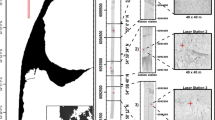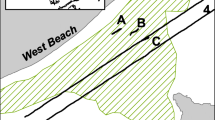Abstract
A technique for the rapid surveying of submersed aquatic vegetation by post-processing of data collected using a high frequency (420 kHz) digital echo sounder (BioSonics DT4000) has recently been developed and successfully tested in an estuarine environment by Sabol et al. [Sabol, B. M., R. E. Melton, R. Chamberlain, P. Doering & K. Haunert, 2002. Evaluation of a digital echo sounder system for detection of submersed aquatic vegetation. Estuaries 25: 133–141.], where it was used to map the cover and height of freshwater tape grass (Vallisneria americana) and seagrasses (Thalassia testudinum, Haladule wrightii and Syringodium filiforme). This technique, which is also spatially referenced by input from a global positioning system, has many potential applications in macrophyte studies in shallow lakes, although it has not yet been extensively tested in such habitats using systems of lower sound frequency. This paper reports such a test in two shallow (maximum depth c. 5.9 m) lakes of the Cotswold Water Park, U.K., using a 200 kHz digital echo sounder (BioSonics DT6000 and DT-X upgrade) and post-processing analysis using the now commercially available software EcoSAV, which incorporates the algorithms of Sabol et al. (2002). Hydroacoustic assessment of the coverage by macrophytes, mainly Nuttall’s pondweed (Elodea nuttallii) and charophytes (Chara spp.), showed high agreement with those recorded during a simultaneous visual survey by underwater video recording (r 2 = 0.8478, n = 74, P < 0.001). Assessment of macrophyte height was also apparently consistent between the two systems, although the video system could not produce quantitative data and so statistical assessment of the agreement was not possible. Repeated hydroacoustic surveys over the course of the winter of 2003–2004 were conducted in one lake and illustrate the application of this new macrophyte survey technique. Such applications include the rapid measurement of mean Percentage Volume Inhabited (PVI), which fell from 12.15% (95% confidence limits, ±0.55%) to 7.10% (±0.40%) over the course of the winter.




Similar content being viewed by others
References
BioSonics, 2004. EcoSAV User Guide. BioSonics, Inc., 4027 Leary Way NW, Seattle, WA 98107, USA.
Bozzano, R., L. Castellano & A. Siccardi, 1998. Characterization of submerged aquatic vegetation by a sector-scanning sonar. In Alippi, A. & G. B. Canelli (eds), Proceedings of the 4th European Conference on Underwater Acoustics. Italian National Research Council, Rome, Italy, pp 159–164.
Duarte C. M., 1987. Use of echosounder tracing to estimate aboveground biomass of submersed plants in lakes. Canadian Journal of Fisheries and Aquatic Science 44: 732–735.
Elliott, J. M., J. M. Fletcher, J. A. Elliott, P. R. Cubby & E. Baroudy, 1996. Changes in the population density of pelagic salmonids in relation to changes in lake enrichment in Windermere (northwest England). Ecology of Freshwater Fish 5: 153–162.
Fortin, G., L. Saint-Cyr & M. LeClerc, 1993. Distribution of submersed macrophytes by echo-sounder tracings in Lake Saint-Pierre, Quebec. Journal of Aquatic Plant Management 31: 232–240.
George, D. G. & I. J. Winfield, 2000. Factors influencing the spatial distribution of zooplankton and fish in Loch Ness, UK. Freshwater Biology 44: 557–570.
Godlewska, M., N. Górska, Z. Klusek, J. Szczucka, A. Świerzowski & J. Tęgowski, 2002. Hydroacoustics as a tool for monitoring the quality of aquatic ecosysytems. Ecology and Ecotechnologies, Proceedings of the Review Conference on the Scientific Cooperation between Austria and Poland, February 24–28, 2002, Scientific Centre of the Polish Academy of Sciences, Vienna, Austria, 2: 287–295.
Godlewska, M., A. Świerzowski & I. J. Winfield, 2004. Hydroacoustics as a tool for studies of fish and their habitat. Ecohydrology & Hydrobiology 4: 417–427.
Guan, W., R. H. Chamberlain, B. M. Sabol & P. H. Doering, 1999. Mapping submersed aquatic vegetation with GIS: evaluation of different interpolation methods. Marine Geodesy 22: 69–91.
Hoffman, J. C., J. Burczynski, B. Sabol & M. Heilman, 2002. Digital acoustic system for ecosystem monitoring and mapping: assessment of fish, plankton, submersed aquatic vegetation, and bottom substrata classification. White Paper. BioSonics, Inc., 4027 Leary Way NW, Seattle, WA 98107, USA. Available at: http://www.biosonicsinc.com/doc_library/docs/lake_wa_assessment.pdf.
Jurvelius J., 1991. Distribution and density of pelagic fish stocks, especially vendace (Coregonus albula (L.)), monitored by hydroacoustics in shallow and deep southern boreal lakes. Finnish Fisheries Research 12: 45–63.
Maceina, M. J. & J. V. Shireman, 1980. The use of a recording fathometer for determination of distribution and biomass of hydrilla. Journal of Aquatic Plant Management 18: 34–39.
Madsen J. D., 1993. Biomass techniques for monitoring and assessing control of aquatic vegetation. Lake and Reservoir Management 7: 141–154.
Mead, R. & R. N. Curnow, 1983. Statistical methods in agriculture and experimental biology. Chapman & Hall, London.
Moreno, A., P. Siljestrom & J. Rey, 1998. Benthic pharenogam species recognition in side scan sonar images: Importance of the sensor direction. In Alippi A. & G. B. Canelli (eds), Proceedings of the 4th European Conference on Underwater Acoustics. Italian National Research Council, Rome, Italy 173–178.
O’Connell, M. J., R. M. Ward, C. Onoufriou, I. J. Winfield, G. Harris, R. Jones, M. L. Yallop & A. F. Brown, in press. Integrating multi-scale data to model the trade off between food resource quality and disturbance risk: preliminary findings & potential uses. Ibis.
Sabol, B. & J. Burczyński, 1998. Digital echo sounder system for characterising vegetation in shallow-water environments. In Alippi, A. & G. B. Canelli (eds), Proceedings of the 4th European Conference on Underwater Acoustics. Italian National Research Council, Rome, Italy: 165–171.
Sabol, B. M., R. E. Melton, R. Chamberlain, P. Doering & K. Haunert, 2002. Evaluation of a digital echo sounder system for detection of submersed aquatic vegetation. Estuaries 25: 133–141.
Schmidt, M. B., H. Gassner & E. I. Meyer, 2005. Distribution and biomass of an underfished vendace, Coregonus albula, population in a mesotrophic German reservoir. Fisheries Management and Ecology 12: 169–175.
Schneider, P., J. Burczynski, A. Monteoliva & A. Valle, 2001. Results from submerged aquatic plant assessment using digital echosounder technique. International Council for the Exploration of the Sea, Joint Session of FTFB and FAST Working Groups, 23–27.
Tęgowski, J., N. Górska & Z. Klusek, 2003. Statistical analysis of acoustic echoes from underwater meadows in the eutrophic PuckBay (southern Baltic Sea). Aquatic Living Resources 16: 215–221.
Thomas, G. L., S. I. Thiesfield, S. A. Bonar, R. N. Crittenden & G. B. Pauley, 1990. Distribution of submergent plant bed biovolume using acoustic range information. Canadian Journal of Fisheries and Aquatic Sciences 47: 805–812.
Valley, R. D., M. T. Drake & C. S. Anderson, 2005. Evaluation of alternative interpolation techniques for the mapping of remotely-sensed submersed vegetation abundance. Aquatic Botany 81: 13–25.
Vis, C., C. Hudon & R. Carignan, 2003. An evaluation of approaches used to determine the distribution and biomass of emergent and submerged aquatic macrophytes over large spatial scales. Aquatic Botany 77: 187–201
Wanzenböck, J., T. Mehner, M. Schulz, H. Gassner & I. J. Winfield, 2003. Quality assurance of hydroacoustic surveys: the repeatability of fish-abundance and biomass estimates in lakes within and between hydroacoustic systems. ICES Journal of Marine Science 60: 486–492.
Acknowledgements
We thank Bob McClure of BioSonics and Bruce Sabol of the U.S. Army Engineer Research and Development Center for their help and advice during our hydroacoustic analyses. We are also grateful to Bob McClure for making the EcoSAV software available to us, and to our colleagues Janice Fletcher and Ben James for help in the field. Boat and other logistical facilities were kindly made available by Gareth Harris and Simon Pickering of the Cotswold Water Park Society. This work was funded by English Nature, the Natural Environment Research Council, the University of Bristol, and the Wildfowl & Wetlands Trust.
Author information
Authors and Affiliations
Corresponding author
Rights and permissions
About this article
Cite this article
Winfield, I.J., Onoufriou, C., O’Connell, M.J. et al. Assessment in two shallow lakes of a hydroacoustic system for surveying aquatic macrophytes. Hydrobiologia 584, 111–119 (2007). https://doi.org/10.1007/s10750-007-0612-y
Issue Date:
DOI: https://doi.org/10.1007/s10750-007-0612-y




